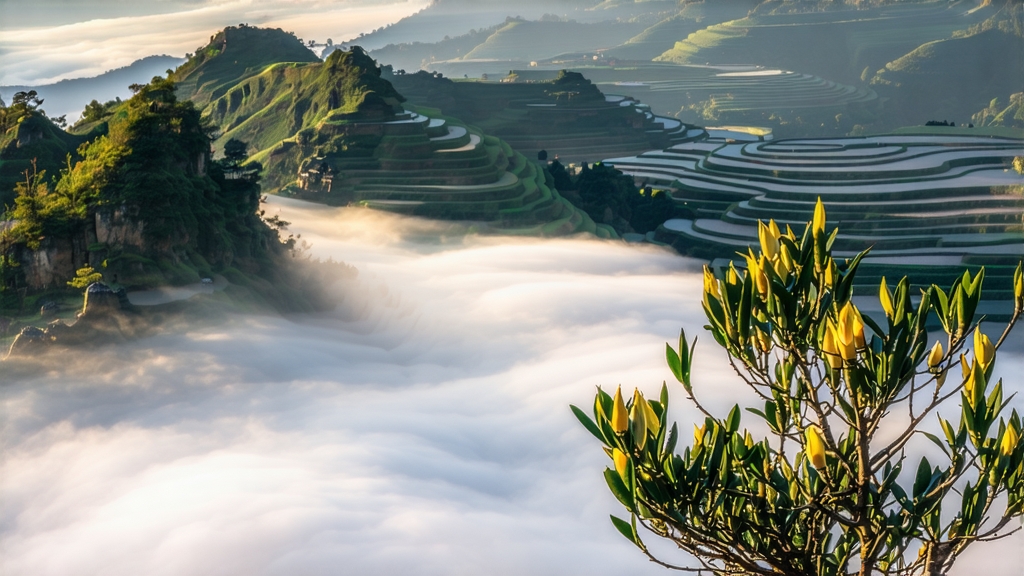
Tucked high on the shoulders of Sichuan’s sacred Meng Ding Shan, where perennial cloud banks stroke 1,450-metre granite ridges, grows a tea so discreet that even seasoned connoisseurs sometimes mistake it for a myth: Meng Ding Huang Ya, literally “Meng Ding Yellow Bud.” Unlike its celebrity cousins Longjing or Da Hong Pao, this yellow tea has never clamoured for the spotlight, yet for more than twelve centuries it was the first spring gift placed before the Dragon Throne. To understand it is to glimpse a vanished China—an empire of poets, porters and palace eunuchs who measured power in leaves and time in breaths.
Historical whispers
Chronicles from the Tang dynasty (618-907 CE) already list “Meng Mountain Bud Tea” among tributes dispatched along the Jiannan caravan road to Chang’an. When Emperor Li Shimin tasted the liquor’s luminous topaz glow, court diarists recorded that “the sovereign smiled for the first time since the famine.” By the Song period the tea was wrapped in silk perfumed with jasmine, sealed with wax bearing the imperial chop, and raced southward on post-horses to beat the Qingming festival deadline—only buds picked before the third lunar month were deemed worthy. The Ming finally codified its manufacture in the “Cha Shu” chapter of the Sichuan Provincial Gazette, noting a mysterious “men huang” (sealed yellowing) step that differentiated it from green tea. After the fall of the Qing, civil wars and the collapse of the tribute system pushed Meng Ding Huang Ya to the brink of extinction; the craft survived only because three monk-tea makers on Tianzimiao Peak refused to abandon their bamboo-roasting frames. When agricultural historians retraced the tea in 1978 they found fewer than two mu (0.13 ha) of ancient bushes left. A state-led restoration followed, yet even today annual production rarely exceeds 1,200 kg—rarer than silver-tipped Darjeeling.
Terroir wrapped in cloud
Meng Ding Shan is the easternmost thrust of the Hengduan Range, tilted like a breaking wave above the Chengdu Plain. Its southern flank catches the Yarlung Tsangpo moisture stream, creating 280 fog-bound days a year. On these slopes the soil is a stony cocktail of weathered granite and phyllite, acidic (pH 4.8-5.2) and laced with selenium leached from Jurassic bedrock. Day-night temperature swings can exceed 15 °C in early April, coaxing the tea bush into a slow-motion photosynthesis that stockpiles theanine while capping bitter catechins. The local cultivar, a Camellia sinensis var. sinensis landrace nicknamed “Gan Ye Zao” (Sweet Leaf Early), keeps its terminal bud squat and downy, the better to resist mountain frost. Each hectare is interplanted with towering ginkgo and evergreen oak whose leaf litter forms a spongy humus, adding a whisper of resinous aroma that later surfaces in the cup as a cool pine-note.
Craft: the art of controlled forgetting
Yellow tea’s identity hinges on one extra, nerve-wracking phase—sealed yellowing—that turns green into gold. Meng Ding Huang Ya undergoes this metamorphosis twice, earning it the local saying “two lives, three sleeps.”
-
Plucking: At daybreak on the first two weeks of April, pickers climb bamboo ladders to reach bushes older than their grandparents. Only the “bud-and-impossible-scale” standard is accepted: an unopened apical bud sheathed in two infant leaves no longer than 2 cm. A skilled woman can gather just 400 g in a dawn shift—barely enough for one finished liang (50 g).
-
Withering: Leaves are laid no thicker than two fingers on hemp trays set inside cliff-side caves where humidity hovers at 78 %. For six hours they lose roughly 8 % moisture while absorbing the cave’s mineral breath, a process locals call “mountain drunkenness.”
-
First fixation: In iron woks heated to 140 °C the buds are tossed by hand for 90 seconds—too short to fully denature enzymes, merely “shocking” them. This partial kill-green preserves the substrates needed for later yellowing.
-
Rolling: A whisper-light rolling—no pressure—follows for eight minutes, just enough to bruise the cuticle and release a veil of sap